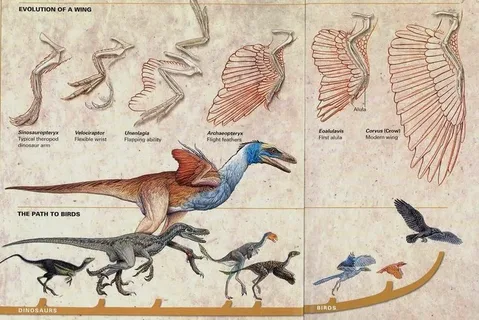Evolution of birds is one of the most fascinating stories in the natural world. It explains how modern birds—like sparrows, eagles, and penguins—are actually the distant relatives of ancient dinosaurs. Over millions of years, birds have transformed from ground-dwelling, meat-eating reptiles into the diverse and colorful flying creatures we see today.
This transformation did not happen overnight. It involved many small changes, such as the development of feathers, lighter bones, and wings. Scientists have discovered fossils, studied bird DNA, and compared ancient species to understand how birds evolved step by step from their dinosaur ancestors.
In this blog, we will take a journey through time to explore the evolution of birds—from their dinosaur beginnings to the modern skies. Whether you’re a young student or an adult curious about nature, this guide will help you understand how birds came to be and why their story is so important.
Introduction: Understanding the Evolution of Birds
Before we explore how modern birds came to exist, it is important to understand what the evolution of birds means.
The term evolution refers to the slow, natural changes that occur in living things over a long time—often millions of years. These changes help animals and plants survive and adapt to their surroundings.
For instance:
- Giraffes with longer necks survived better by eating leaves from tall trees and passed on this trait.
- Similarly, some dinosaurs developed feathers. Over time, these feathered dinosaurs evolved into birds.
This process, which happened gradually, is what scientists call the evolution of birds.
Birds Are Living Dinosaurs: A Key Discovery in the Evolution of Birds
It might be surprising, but birds did not just appear suddenly. They evolved from a group of dinosaurs known as theropods, which were meat-eating and walked on two legs.
What were theropods?
Theropods were:
- Dinosaurs like Velociraptor,
- Fast and agile hunters,
- Some had feathers, although they did not fly.
Over millions of years, these creatures developed feathers, hollow bones, and changes in their body structure. These adaptations helped them become lighter and eventually led to flight. These evolutionary changes marked the early stages in the evolution of birds.
So, birds are not only related to dinosaurs—they are modern-day dinosaurs.
Feathers and Flight: An Important Part of the Evolution of Birds
Feathers are central to the evolution of birds, but they did not start out for flying.
Why did feathers first evolve?
Scientists believe feathers were originally used for:
- Keeping the body warm (insulation),
- Camouflage (blending into the environment),
- Displaying beauty to attract mates (as peacocks do today).
Later, feathers became longer and more developed, allowing ancient animals to glide through the air. Eventually, these feathers allowed for full flight, which became a major milestone in the evolution of birds.
Archaeopteryx: The First Known Step in the Evolution of Birds
About 150 million years ago, during the Jurassic Period, a unique creature called Archaeopteryx lived on Earth. It is known as the earliest true bird and is one of the most important fossils in the study of the evolution of birds.
Features of Archaeopteryx:
- Wings with feathers capable of gliding,
- Sharp teeth (unlike modern birds),
- Three clawed fingers,
- A long bony tail,
- Light and hollow bones.
Archaeopteryx looked like a mix between a small dinosaur and a bird. Its fossil provides strong evidence of the evolution of birds from feathered dinosaurs.
Step-by-Step Evolution of Birds Over Time
The evolution of birds was a slow process that occurred over millions of years. Birds did not appear suddenly but went through several stages.
Major stages in the evolution of birds:
- Feathered dinosaurs like Microraptor could glide using feathered arms and tails.
- Early birds such as Archaeopteryx had both dinosaur and bird-like features.
- True birds developed shorter tails, lost their teeth, and had stronger flight muscles.
- Modern birds became highly diverse, adapting to fly, swim, or run depending on their environment.
Each of these stages helped birds survive better in changing environments and led to the rich variety we see today.

How the Evolution of Birds Survived the Mass Extinction
About 66 million years ago, a large asteroid hit the Earth, leading to a mass extinction event. Most dinosaurs died, but some bird-like dinosaurs survived, continuing the evolution of birds.
Why did birds survive while other dinosaurs went extinct?
- They were small and could hide in small spaces.
- They had a varied diet including seeds, insects, and fruits.
- Their ability to fly helped them escape danger.
- They could nest in trees, keeping them safe from ground predators.
These surviving species kept evolving and spread across the planet, continuing the successful evolution of birds into the modern world.
The Great Bird Explosion: Diversity After Evolution
After the mass extinction, the world was empty of large reptiles. This gave birds an opportunity to grow in number and variety. This phase is called the great bird radiation—a key part of the evolution of birds.
Examples of how birds evolved differently:
- Penguins became expert swimmers but lost the ability to fly.
- Ostriches and emus became strong runners with large legs.
- Hummingbirds evolved to hover and feed on nectar.
- Birds of prey like eagles developed strong beaks and claws for hunting.
Today, over 10,000 bird species live on Earth, showing the success and diversity of the evolution of birds.
What Science Tells Us About the Evolution of Birds
Modern science uses tools like fossils, DNA, and embryo research to understand the evolution of birds.
Key evidence:
- Fossils show feathers, bone structure, and footprints.
- DNA studies reveal that bird genes closely match those of certain dinosaurs.
- Embryo development in birds shows traits like tiny tails and teeth that vanish before hatching.
All this research confirms that birds evolved from dinosaurs and carry ancient traits.
Modern Birds Still Carry Dinosaur Traits
Although birds appear very different now, they still hold many clues from their dinosaur past.
Some examples:
- Scaly legs, similar to dinosaur skin,
- Laying eggs, just like reptiles,
- Hollow bones and sharp claws,
- Hip and skull shapes that match those of theropods.
These features prove that the evolution of birds did not erase the past—it built on it.
Timeline of the Evolution of Birds
| Time Period | Key Event |
|---|---|
| 230 million years ago | Dinosaurs first appear |
| 160 million years ago | Feathered dinosaurs like Microraptor emerge |
| 150 million years ago | Archaeopteryx lives, early bird stage begins |
| 66 million years ago | Mass extinction event, most dinosaurs die |
| 60 to 5 million years ago | Birds evolve and diversify across the globe |
| Present day | Over 10,000 bird species live worldwide |
Why Learning About the Evolution of Birds Matters
The evolution of birds is more than a story about animals—it helps us understand:
- How life changes and adapts to survive,
- How big changes can start from small traits,
- That all living things are connected across time.
Birds also help us study topics like climate, migration, natural history, and ecosystems, making them a vital part of the living world.
Conclusion: The Evolution of Birds is Nature’s Greatest Flight
From giant dinosaurs to tiny sparrows, the evolution of birds is one of the most remarkable journeys in nature. It shows how species adapt to survive and thrive, even after mass extinctions.
The next time you see a bird in the sky, remember—it carries millions of years of history. It is a living descendant of ancient dinosaurs and a symbol of survival, change, and natural wonder.
Frequently Asked Questions (FAQs)
Q1. Are birds reptiles or mammals?
Birds are reptiles because they evolved from dinosaurs, which are part of the reptile group.
Q2. Did all dinosaurs have feathers?
Not all, but many small theropods had feathers.
Q3. What is the closest living relative of dinosaurs?
Birds are the closest living relatives and are considered modern dinosaurs.
Q4. Why were feathers important in evolution?
Feathers provided warmth, helped in mating displays, camouflage, and eventually enabled flight.
Q5. How do scientists know birds came from dinosaurs?
Through fossil discoveries, DNA comparisons, and similarities in bones and body structure.












